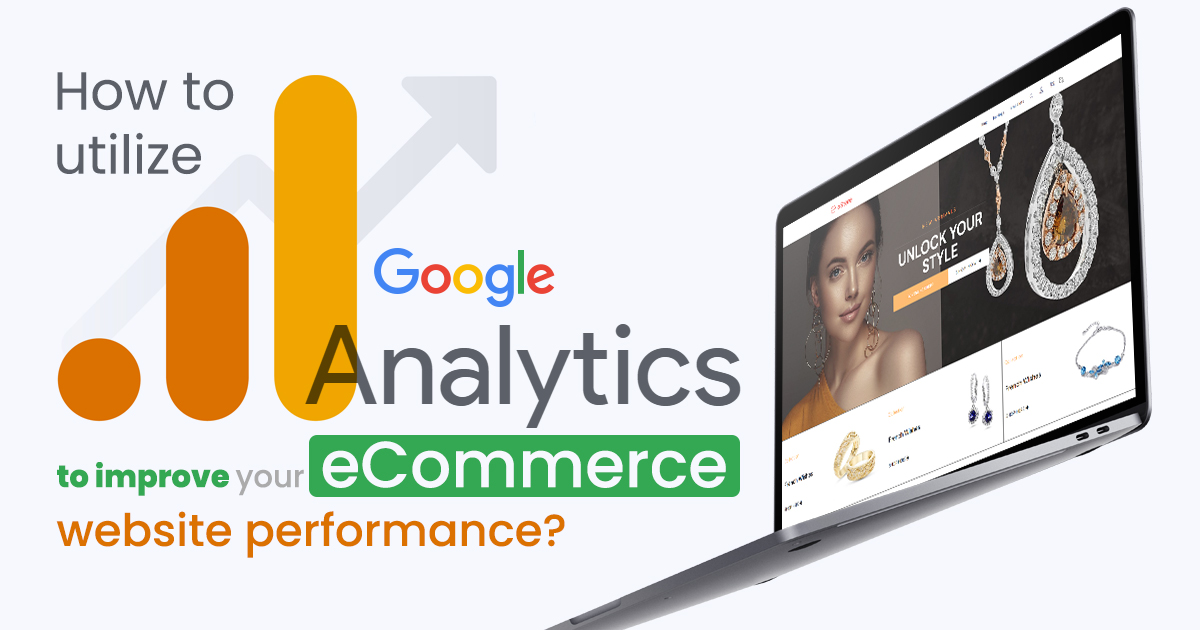How to Utilize Google Analytics to Improve Your eCommerce Performance?

Google Analytics is a powerful tool that can provide valuable insights into the behaviour of your website visitors. By using the platform, e-commerce business owners can gain insights into the customer journey, track conversions, and optimize their website for better performance.
Here are some ways to utilize Google Analytics to improve your e-commerce performance.
1. Set up Google Analytics correctly
Before you can start utilizing Google Analytics, it is essential to set it up correctly. You need to create an account, set up tracking codes, and add them to your website’s pages. Google Analytics provides a simple and straightforward setup guide that you can follow to get started.
2. Set up E-commerce tracking
Once you have set up Google Analytics, the next step is to set up e-commerce tracking. E-commerce tracking enables you to track important metrics such as revenue, transaction volume, and average order value. You can use this data to identify trends and make informed decisions to improve your e-commerce performance.
To set up e-commerce tracking in Google Analytics, you need to enable e-commerce tracking in your account settings and add the necessary tracking code to your website. You can also track other important metrics such as cart abandonment rate, checkout abandonment rate, and product performance.
3. Analyze customer behaviour
Google Analytics provides valuable insights into customer behaviour on your website. You can track the pages customers visit, the products they view, and the time they spend on your website. By analyzing customer behaviour, you can identify trends and areas for improvement.
For example, if customers are spending a lot of time on a particular page, it may indicate that the page is providing valuable information or that customers are having difficulty finding what they need. You can use this information to optimize the page and make it more user-friendly.
4. Analyze traffic sources
Google Analytics can help you identify where your website traffic is coming from. You can track the sources of traffic such as search engines, social media, and referral sites. By analyzing traffic sources, you can identify the channels that are driving the most traffic to your website and optimize them for better performance.
For example, if most of your traffic is coming from search engines, you can optimize your website for better search engine rankings. If most of your traffic is coming from social media, you can increase your social media marketing efforts to drive more traffic to your website.
5. Analyze conversion rates
One of the most important metrics to track in e-commerce is conversion rates. Conversion rates measure the percentage of visitors who complete a desired action such as making a purchase or filling out a form. By analyzing conversion rates, you can identify areas where you can improve your website and increase conversions.
For example, if you notice a high cart abandonment rate, you can optimize your checkout process to make it more user-friendly. If you notice a low conversion rate on a particular product page, you can optimize the page to make it more appealing to customers.
6. Use A/B testing
A/B testing is a technique that involves testing two different versions of a web page to see which one performs better. By using A/B testing, you can test different website elements such as headlines, images, and calls to action to see which version performs better.
For example, you can test two different headlines on a product page to see which one generates more clicks and conversions. You can then use the results to optimize the page and increase conversions.
7. Use Google Analytics to optimize your marketing campaigns
Google Analytics can help you optimize your marketing campaigns by providing valuable insights into campaign performance. You can track metrics such as click-through rate, cost per click, and conversion rate to identify which campaigns are generating the best results.
For example, if you notice that a particular advertising campaign is generating a high cost per click but a low conversion rate, you may need to adjust your ad targeting or messaging to improve performance.
You can also use Google Analytics to track the performance of different marketing channels such as email, social media, and search engine marketing. By analyzing the performance of each channel, you can identify which channels are driving the most traffic and conversions and adjust your marketing strategy accordingly.
8. Monitor website performance
Google Analytics can also be used to monitor website performance. You can track website speed, page load times, and other performance metrics to identify areas for improvement. By optimizing website performance, you can improve the user experience and increase conversions.
For example, if you notice that your website is slow to load, you may need to optimize images or reduce the number of plugins on your website. By improving website speed, you can reduce bounce rates and improve the user experience.
9. Use custom reports and dashboards
Google Analytics provides a wide range of standard reports and dashboards, but you can also create custom reports and dashboards to track the metrics that are most important to your business. Custom reports and dashboards enable you to focus on the metrics that matter most and make informed decisions to improve your e-commerce performance.
For example, you can create a custom dashboard that tracks conversion rates, revenue, and traffic sources to get a quick snapshot of your website’s performance.
Conclusion
Google Analytics is a powerful tool that can provide valuable insights into the behaviour of your website visitors. By utilizing Google Analytics, e-commerce business owners can gain insights into the customer journey, track conversions, and optimize their websites for better performance. By following the tips outlined in this article, you can use Google Analytics to improve your e-commerce performance and grow your business.
Looking for a reliable eCommerce partner in Jaipur? Look no further than our all-in-one eCommerce solutions.
Are you a traditional business ready to make a big leap into the online world? Or perhaps you’re looking to give your existing eCommerce platform a modern makeover? Whatever your needs may be, we’ve got you covered!
Our team is armed with the expertise and know-how to help you navigate through the entire process seamlessly. We don’t just stop at website design and development – we provide a full suite of digital marketing and analytics tools to help ensure your success. Don’t settle for anything but the best! Contact us today
Subscribe to our Blog
Read our newly created blogs delivered straight to your inbox.


